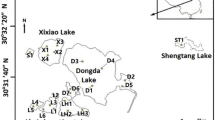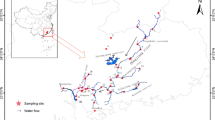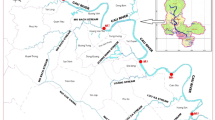Abstract
The occurrence of eight perfluorinated compounds (PFCs) in the surface sediments from 10 sampling sites spread across the Danjiangkou Reservoir was investigated by isotope dilution ultra-high-performance liquid chromatography-tandem mass spectrometry (UPLC-MS/MS) after solid-phase extraction (SPE). All the sediments from the 10 sites contained detectable levels of PFCs. The total concentration of the target PFCs in each sediment sample (C∑PFCs) ranged from 0.270 to 0.395 ng g−1 of dry weight, and the mean value of C∑PFCs was 0.324 ± 0.045 ng g−1 of dry weight for the whole reservoir. For each perfluorinated compound in one sediment, perfluorooctane sulfonate (PFOS) or perfluoro-n-butanoic acid (PFBA) consistently had a higher concentration than the other six PFCs, while perfluoro-n-octanoic acid (PFOA) was always undetectable. In terms of spatial distribution, the total and individual concentrations of PFCs in sediment from downstream sites of the Danjiangkou Reservoir were higher than those from upstream sites. Factor analysis revealed that PFCs in the sediment samples originated from electroplating and anti-fog agents in industry, food/pharmaceutical packaging and the water/oil repellent paper coating, and the deposition process. The quotient method was utilized to assess the ecological risk of PFCs in the sediments of the Danjiangkou Reservoir, which showed that the concentrations of PFCs were not considered a risk. In this study, detailed information on the concentration level and distribution of PFCs in the sediments of the Danjiangkou Reservoir, which is the source of water for the Middle Route Project of the South-to-North Water Transfer Scheme in China, was reported and analyzed for the first time. These results can provide valuable information for water resource management and pollution control in the Danjiangkou Reservoir.



Similar content being viewed by others
References
Ahrens, L., Yamashita, N., Yeung, L. W. Y., Taniyasu, S., Horii, Y., & Lam, P. K. S. (2009). Partitioning behavior of per- and polyfluoroalkyl compounds between pore water and sediment in two sediment cores from Tokyo Bay, Japan. Environ. Science and Technology, 43(18), 6969–6975. https://doi.org/10.1021/es901213s.
Bao, J., Jin, Y., Liu, W., Ran, X., & Zhang, Z. (2009). Perfluorinated compounds in sediments from the Daliao River system of northeast China. Chemosphere, 77(5), 652–657. https://doi.org/10.1016/j.chemosphere.2009.08.018.
Bao, J., Liu, W., Liu, L., Jin, Y. H., Ran, X. R., & Zhang, Z. X. (2010). Perfluorinated compounds in urban river sediments from Guangzhou and Shanghai of China. Chemosphere, 80(2), 123–130. https://doi.org/10.1016/j.chemosphere.2010.04.008.
Becker, A. M., Gerstmann, S., & Frank, H. (2008). Perfluorooctanoic acid and perfluorooctane sulfonate in the sediment of the Roter Main river, Bayreuth. Germany. Environmental Pollution, 156(3), 818–820. https://doi.org/10.1016/j.envpol.2008.05.024.
Brooke, D., Footitt, A., & Nwaogu, T. A. (2004). Environmental risk evaluation report: perfluorooctanesulphonate (PFOS). Wallingford: Environment Agency, Chemicals Assessment Section.
Bu, Q. W., Wang, D. H., Wang, Z. J., & GU, J. N. (2014). Identification and ranking of the risky organic contaminants in the source water of the Danjiangkou reservoir. Front. Env. The Sciences and Engineering, 8(1), 42–53. https://doi.org/10.1007/s11783-013-0499-y.
Chen, H., Guo, S. L., Xu, C. Y., & Singh, V. P. (2007). Historical temporal trends of hydroclimatic variables and runoff response to climate variability and their relevance in water resource management in the Hanjiang basin. Journal of Hydrology, 344(3-4), 171–184. https://doi.org/10.1016/j.jhydrol.2007.06.034.
Corsolini, S., Sarkar, S. K., Guerranti, C., Bhattacharya, B. D., Rakshit, D., Jonathan, M. P., Godhantaraman, N. (2012). Perfluorinated compounds in surficial sediments of the ganges river and adjacent sundarban mangrove wetland, india. Marine Pollution Bulletin, 64(12), 2829–33.
Dreyer, A., Weinberg, I., Temme, C., & Ebinghaus, R. (2009). Polyfluorinated compounds in the atmosphere of the Atlantic and southern oceans: evidence for a global distribution. Environmental Science & Technology, 43(17), 6507–6514. https://doi.org/10.1021/es9010465.
Ellis, D. A., Martin, J. W., DeSilva, A. O., Mabury, S. A., Hurley, D., Andersen, M. P. S., & Wallington, T. J. (2004). Degradation of fluorotelomer alcohols: a likely atmospheric source of perflu-orinated carboxylic acids. Environmental Science & Technology, 38(12), 3316–3321. https://doi.org/10.1021/es049860w.
Gloria, B. P., Judith, B. L., Cooper, K. R., Boros-Russo, B. J., & Lee Lippincott, R. (2009). Occurrence and potential significance of perfluorooctanoic acid (PFOA) detected in New Jersey public drinking water systems. Environmental Science & Technology, 43, 4547–4554.
Gomez, C., Vicente, J., Echavarri-Erasun, B., Porte, C., & Lacorte, S. (2011). Occurrence of perfluorinated compounds in water, sediment and mussels from the Cantabrian Sea (North Spain). Marine Pollution Bulletin, 62(5), 948–955. https://doi.org/10.1016/j.marpolbul.2011.02.049.
Gong, X., Li, B., Liu, Y., Liu, R., Song, Y. (2015). Pollution levels and ecological risk assessment of typical perfluorinated compounds in riverine water and sediments of hun river and daliao river watershed. Acta Scientiae Circumstantiae (in Chinese), 35(7), 2177-2184.
Goosey, E., & Harrad, S. (2012). Perfluoroalkyl substances in UK indoor and outdoor air: Spatial and seasonal variation, and implications for human exposure. Environment International, 45, 86–90. https://doi.org/10.1016/j.envint.2012.04.007.
Guruge, K. S., Taniyasu, S., Yamashita, N., Wijeratna, S., Mohotti, K. M., Seneviratne, H. R., Kannan, K., Yamanaka, N., & Miyazaki, S. (2005). Perfluorinated organic compounds in human blood serum and seminal plasma: a study of urban and rural tea worker populations in Sri Lanka. Journal of Environmental Monitoring, 7(4), 371–377. https://doi.org/10.1039/b412532k.
Hanssen, L., Röllin, H., Odland, J., Moe, M. K., & Sandanger, T. M. (2010). Perfluorinated compounds in maternal serum and cord blood from selected areas of South Africa: results of a pilot study. Journal of Environmental Monitoring, 12(6), 1355–1361. https://doi.org/10.1039/b924420d.
He, X. M., & Chen, H. (2014). Determination of eight perfluorinated compounds in fish muscles by isotope dilution ultra performance liquid chromatography-tandem mass spectrometry. Food Science (in Chinese)., 35(8), 193–197.
He, X. M., Dai, K., Li, A. M., & Chen, H. (2015). Occurrence and assessment of perfluorinated compounds in fish from the Danjiangkou Reservoir and Hanjiang River in China. Food Chemistry, 174, 180–187. https://doi.org/10.1016/j.foodchem.2014.11.018.
Higgins, C. P., Field, J. A., Criddle, C. S., & Luthy, R. G. (2005). Quantitative determination of perfluorochemicals in the sediments and domestic sludge. Environmental Science & Technology, 39(11), 3946–3956. https://doi.org/10.1021/es048245p.
Kelly, J., & Solem, L. (2009). Identification of a major source of perfluorooctane sulfonate (PFOS) at a wastewater treatment plant in Brainerd, Minnesota. Reproductive Toxicology., 19(6), 303–304.
Kubwabo, C., Vais, N., & Benoit, F. M. (2004). A pilot study on the determination of perfluorooctanesulfonate and other perfluorinated compounds in blood of Canadians. Journal of Environmental Monitoring, 6(6), 540–545. https://doi.org/10.1039/b314085g.
Labadie, P., & Chevreuil, M. (2011). Partitioning behaviour of perfluorinated alkyl contaminants between water, sediment and fish in the Orge River (nearby Paris, France). Environmental Pollution, 159(2), 391–397. https://doi.org/10.1016/j.envpol.2010.10.039.
Lau, C., Butenhoff, J. L., & Rogers, J. M. (2004). The developmental toxicity of perfluoroalkyl acids and their derivatives. Toxicology and Applied Pharmacology, 198(2), 231–241. https://doi.org/10.1016/j.taap.2003.11.031.
Lei, P. (2012). Research for analysis of pollution source of Danjiangkou Reservoir area and upper Recheasand characteristics of water quality risk of the representative input tributaries of Danjiangkou Reservoir. Master thesis: Wuhan University of Technology.
Li, F. S., Sun, H. W., Hao, Z. N., He, N., Zhao, L. J., Zhang, T., & Sun, T. H. (2011). Perfluorinated compounds in Haihe River and Dagu Drainage Canal in Tianjin, China. Chemosphere, 84(2), 265–271. https://doi.org/10.1016/j.chemosphere.2011.03.060.
Li, S., Gu, S., Liu, W., Han, H., & Zhang, Q. (2008). Water quality in relation to land use and land cover in the upper Han River Basin, China. Catena, 75(2), 216–222. https://doi.org/10.1016/j.catena.2008.06.005.
Liu, Y., Tao, Y., Wan, K. Y., Zhang, G. S., Liu, D. B., Xiong, G. Y., & Chen, F. (2012). Runoff and nutrient losses in citrus orchards on sloping land subjected to different surface mulching practices in the Danjiangkou Reservoir area of China. Agric Water Manag, 110, 34–40. https://doi.org/10.1016/j.agwat.2012.03.011.
Liu, B. L., Zhang, H., Xie, L. W., Wang, Y. P., & Wang, X. X. (2015). Spatial distribution and source of perfluorinated compounds in surface soils around the Dongjiang river. Earth Environ, 43(3), 302–307.
Ma, R. W., & Shih, K. (2010). Perfluorochemicals in wastewater treatment plants and the sediments in Hong Kong. Environmental Pollution, 158(5), 1354–1362. https://doi.org/10.1016/j.envpol.2010.01.013.
Martin, J. W., Whittle, D. M., Muir, D. C. G., & Mabury, S. A. (2004). Perfluoroalkyl contaminants in a food web from Lake Ontario. Environmental Science & Technology, 38(20), 5379–5385. https://doi.org/10.1021/es049331s.
Meng, J., Wang, T. Y., Wang, P., Giesy, J. P., & Lu, Y. L. (2014). Perfluoroalkyl substances and organochlorine pesticides in the sediments from Huaihe watershed in China. Journal of Environmental Sciences, 26(11), 2198–2206. https://doi.org/10.1016/j.jes.2014.09.002.
Naile, J. E., Khim, J. S., Wang, T. Y., Chen, C. L., Luo, W., Kwon, B. O., Park, J., Koh, C. H., Jones, P. D., Lu, Y. L., & Giesy, J. P. (2010). Perfluorinated compounds in water, sediment, soil and biota from estuarine and coastal areas of Korea. Environmental Pollution, 158(5), 1237–1244. https://doi.org/10.1016/j.envpol.2010.01.023.
Nakata, H., Kannan, K., Nasu, T., Cho, H., Sinclair, E., & Takemura, A. (2006). Perfluorinated contaminats in the sediments and aquatic organisms collected from shallow water and tidal flat areas of the Ariake Sea, Japan: environmental fate of perfluorooctane sulfonate in aquatic ecosystems. Environmental Science & Technology, 40(16), 4916–4921. https://doi.org/10.1021/es0603195.
Pan, Y., Shi, Y., Wang, Y., Cai, Y., & Jiang, G. (2010). Investigation of perfluorinated compounds (PFCs) in mollusks from coastal waters in the Bohai Sea of China. Journal of Environmental Monitoring, 12(2), 508–513. https://doi.org/10.1039/B909302H.
Prevedouros, K., Cousins, I. T., Buck, R. C., & Korzeniowski, S. H. (2006). Sources, fate and transport of perfluorocarboxylates. Environmental Science & Technology, 40(1), 32–44. https://doi.org/10.1021/es0512475.
Qi, Y. J., Hu, S. B., Huo, S. L., Xi, B. D., Zhang, J. T., & Wang, X. W. (2015). Spatial distribution and historical deposition behaviors ofperfluoroalkyl substances (PFASs) in the sediments of Lake Chaohu, ashallow eutrophic lake in eastern China. Ecological Indicators, 57, 1–10. https://doi.org/10.1016/j.ecolind.2015.04.015.
Senthilkumar, K., Ohi, E., Sajwan, K., Takasuga, T., & Kannan, K. (2007). Perfluorinated compounds in river water, river sediment, market fish, and wildlife samples from Japan. Bulletin of Environmental Contamination and Toxicology, 79(4), 427–431. https://doi.org/10.1007/s00128-007-9243-2.
So, M. K., Yamashita, N., Taniyasu, S., Jiang, Q., Giesy, J. P., Chen, K., & Lam, P. K. S. (2006). Health risks in infants associated with exposure to perfluorinated compounds in human breast milk from Zhoushan, China. Environ. Sci. Technol., 40(9), 2924–2929. https://doi.org/10.1021/es060031f.
Thompson, J., Roach, A., Eaglesham, G., Bartkow, M. E., Edge, K., & Mueller, J. F. (2011). Perfluorinated alkyl acids in water, sediment and wildlife from Sydney Harbour and surroundings. Marine Pollution Bulletin, 62(12), 2869–2875. https://doi.org/10.1016/j.marpolbul.2011.09.002.
Wang, J. X., Song, G. Q., Li, A. M., Henkelmann, B., Pfister, G., Tong, A. Z., & Schramm, K. W. (2014). Combined chemical and toxicological long-term monitoring for AhR agonists with SPMD-based virtual organisms in drinking water Danjiangkou Reservoir, China. Chemosphere, 108, 306–313. https://doi.org/10.1016/j.chemosphere.2014.01.056.
Wang, P., Wang, T. Y., Giesy, J. P., & Lu, Y. L. (2013). Perfluorinated compounds in soils from Liaodong Bay with concentrated fluorine industry parks in China. Chemosphere, 91(6), 751–757. https://doi.org/10.1016/j.chemosphere.2013.02.017.
Wang, T. Y., Lu, Y. L., Chen, C. L., Naile, J. E., Khim, J. S., Park, J., Luo, W., Jiao, W. T., Hu, W. Y., & Giesy, J. P. (2011). Perfluorinated compounds in estuarine and coastal areas of north Bohai Sea, China. Mar. Pollut. Bull., 62(8), 1905–1914. https://doi.org/10.1016/j.marpolbul.2011.05.029.
Xiao, F., Halbach, T. R., Simcik, M. F., & Gulliver, J. S. (2012). Input characterization of perfluoroalkyl substances in wastewater treatment plants: source discrimination by exploratory data analysis. Water Research, 46(9), 3101–3109. https://doi.org/10.1016/j.watres.2012.03.027.
Yang, L. P., Zhu, L. Y., & Liu, Z. T. (2011). Occurrence and partition of perfluorinated compounds in water and sediment from Liao River and Taihu Lake, China. Chemosphere, 83(6), 806–814. https://doi.org/10.1016/j.chemosphere.2011.02.075.
Zhao, X. L., Xia, X. H., Zhang, S. W., Wu, Q., & Wang, X. J. (2014). Spatial and vertical variations of perfluoroalkyl substances inthe sediments of the Haihe River, China. J. Environ. Sci.-China., 26(8), 1557–1566. https://doi.org/10.1016/j.jes.2014.05.023.
Zhao, Z., Tang, J. H., Xie, Z. Y., Chen, Y. J., Pan, X. H., Zhong, G. C., Sturm, R., Zhang, G., & Ebinghaus, R. (2013). Perfluoroalkyl acids (PFAAs) in riverine and coastal the sediments of Laizhou Bay, North China. Sci. Total Environ., 447, 415–423. https://doi.org/10.1016/j.scitotenv.2012.12.095.
Zheng, H., Hu, G. C., Xu, Z. C., Li, H. S., Chen, L. G., Peng, X. W., Ren, M. Z., Guo, S., & Liu, Y. (2013). Contamination characteristics of perfluorooctanoic acid and perfluorooctane sulfonate in surface sediments from Dongjiang River, South China. J. Agro- Environmental Sciences, 32, 778–782.
Zhu, Y. P., Zhang, H. P., Chen, L., & Zhao, J. F. (2008). Influence of the south–north water diversion project and the mitigation projects on the water quality of Han River. Sci. Total Environ., 406(1-2), 57–68. https://doi.org/10.1016/j.scitotenv.2008.08.008.
Zhu, Z. Y., Wang, T. Y., Wang, P., Lu, Y. L., & Giesy, J. P. (2014). Perfluoroalkyl and polyfluoroalkyl substances in the sediments from South Bohai coastal watersheds, China. Marine Pollution Bulletin, 85(2), 619–627. https://doi.org/10.1016/j.marpolbul.2013.12.042.
Funding
This research was financially supported by the Sino-Norwegian Cooperative Project on Persistent Organic Pollutants (POPs) (Project No. C/V/S/12/067), the National Natural Science Foundation of China (21502059), and Fundamental Research Funds for the Central Universities of China (2015BQ044).
Author information
Authors and Affiliations
Corresponding author
Rights and permissions
About this article
Cite this article
He, X., Li, A., Wang, S. et al. Perfluorinated substance assessment in sediments of a large-scale reservoir in Danjiangkou, China. Environ Monit Assess 190, 66 (2018). https://doi.org/10.1007/s10661-017-6439-8
Received:
Accepted:
Published:
DOI: https://doi.org/10.1007/s10661-017-6439-8




